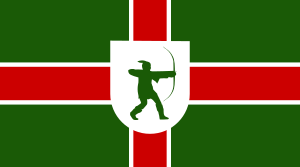 |
| Second Boer War: Boers at Spion Kop, 1900 |
 |
Sketch map showing the situation of the Battle of Spion Kop,
23-24 January 1900 |
The
Second Boer War took place between 1899 and 1902 and was fought between the Dutch settlers (
Boers) of the independent
Transvaal Republic and the
Orange Free State, and the
British Government which was seeking to annexe the two territories into a larger
South African state. With
British forces poised on their borders, the leaders of the two Boer states delivered an ultimatum for the British forces to withdraw within a 48 hour period or face the consequences. The British ignored the ultimatum and war was declared by the two colonies on the 11th October 1899. Initially, the war went well for the Boers as they laid siege to many British settlements, chief amongst them Kimberley, Mafeking and Ladysmith. One of the advances by the British forces was towards Ladysmith in order to relieve the garrison there. In their way, across the
Tugela River was a series of hills, the most prominent being Spion Kop, or
Spy Hill, and it was here that the Boer forces had a defensive position. In order to get to Ladysmith, the British had to capture Spion Kop which they did following an attack on its heights on the night of 23rd January 1900. Although the Boers were driven off, the attack had taken place in dense mist and the British failed to see the Boer positions on the surrounding hills. The hilltop was rugged and totally unsuitable for entrenchment, so, when the mists had cleared the next day, the British forces atop the hill were totally exposed to the Boers' artillery and rifle fire. The confused nature of the battle saw some of the British forces retreat whilst others were sent up the hill as reinforcements. At the end of the 24th January 1900, the British had retreated in defeat leaving around 350 British dead and nearly 1,000 wounded.
 |
| British Soldiers Engaging the Enemy |
I would encourage the reader to study this conflict in more depth as the above paragraph doesn't do justice to the story of those people who experienced it and suffered, whether indigenous black, Dutch white, British Empire white or people settled from other countries (Indian, Chinese, etc.). Some of the experiences were precursors to future conflicts whether it was the trench warfare of the First World War or the concentration camps of the Second World War.
 |
| Sheffield United Kop |
 |
| Sheffield Wednesday Kop |
The point of the above is to show that the Second Boer War had a profound effect on the British people and especially the Battle of Spion Kop. The village we travelled through took its name from it and, I would suggest, was built not long after the war had ended. Similarly, and probably most striking due to the working class nature of football and rugby league at the time, many of the large terraces at the football grounds and rugby league grounds adopted the name of "Spion Kop" as they reminded many people of the steep South African slopes up which many of their fathers, uncles, brothers and sons fought and died. The name stuck and many grounds around the country still have an end, normally all-seater in this day and age known as "The Kop".
 |
| Liverpool Kop |
 Last week, I had the need to travel northwards for a meeting in Worksop for my employer. There were four of us squeezed into a pokey little Ford Fiesta as we set off for the wilds of Nottinghamshire with one of Robin Hood's County's own sons at the wheel. Being from around the Worksop area, he took us on the "scenic" route, showing us the countryside near the town where he grew up, Sutton-in-Ashfield which is close to Mansfield. Driving up the A60, exiting Mansfield Woodhouse and heading towards Warsop, the weary traveller (well I was tired by then) enters a "blink and you'll miss it" village by the strange name of Spion Kop. The question came from the back seat to the driver, he of local knowledge, "How do you pronounce that name?" and "Why is it called that?" The driver was able to tell us what the village's name was, but was flummoxed as to the whys and wherefores of how the village came by its obviously non-English name. Fortunately for the other three occupants of the car, I am at heart a historian and was able to fill in the gaps for them.
Last week, I had the need to travel northwards for a meeting in Worksop for my employer. There were four of us squeezed into a pokey little Ford Fiesta as we set off for the wilds of Nottinghamshire with one of Robin Hood's County's own sons at the wheel. Being from around the Worksop area, he took us on the "scenic" route, showing us the countryside near the town where he grew up, Sutton-in-Ashfield which is close to Mansfield. Driving up the A60, exiting Mansfield Woodhouse and heading towards Warsop, the weary traveller (well I was tired by then) enters a "blink and you'll miss it" village by the strange name of Spion Kop. The question came from the back seat to the driver, he of local knowledge, "How do you pronounce that name?" and "Why is it called that?" The driver was able to tell us what the village's name was, but was flummoxed as to the whys and wherefores of how the village came by its obviously non-English name. Fortunately for the other three occupants of the car, I am at heart a historian and was able to fill in the gaps for them.






No comments:
Post a Comment